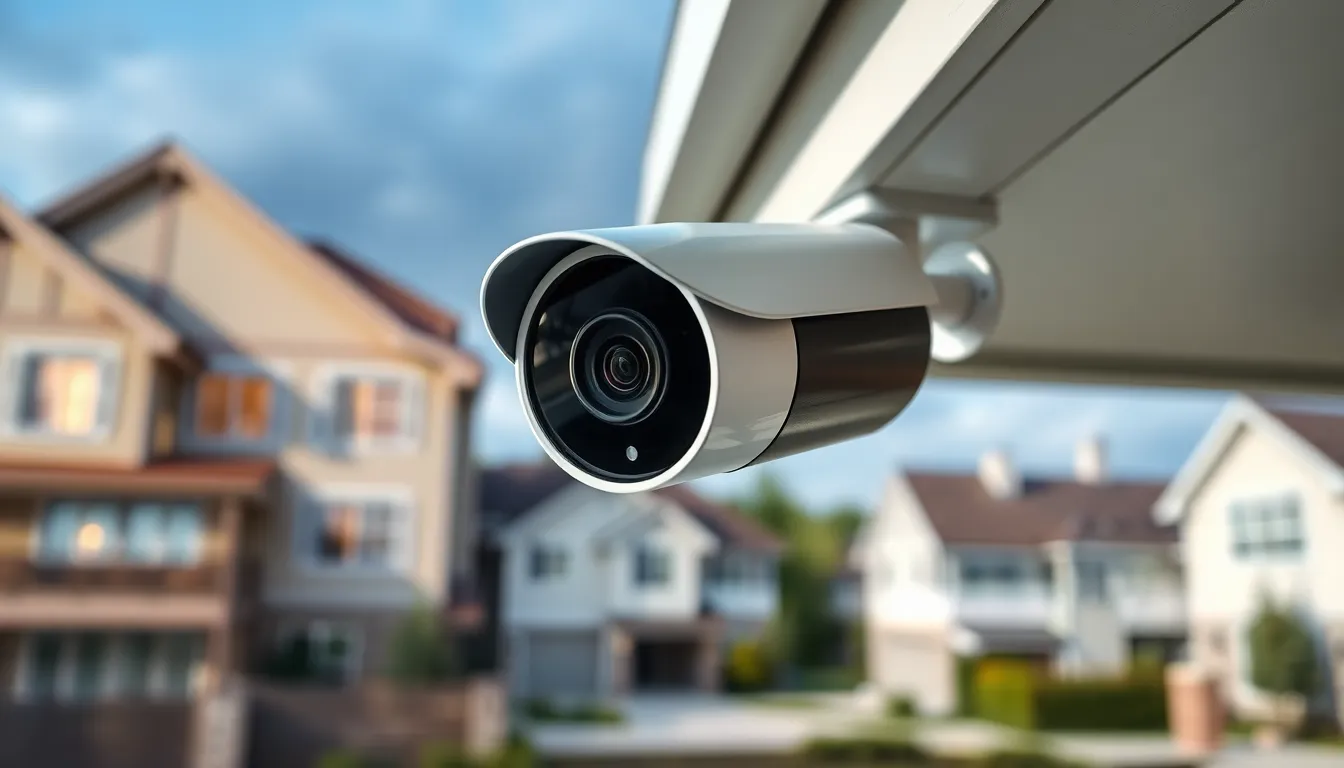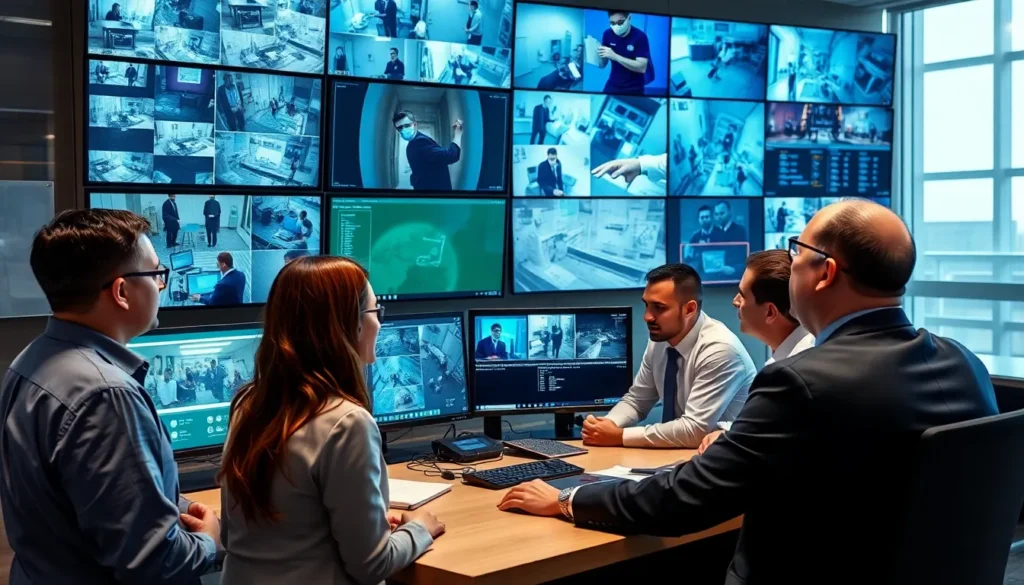In a world where the only thing more advanced than technology is the creativity of burglars, high-tech security has become a must-have. Gone are the days of flimsy locks and neighborhood watch signs. Today’s security solutions are smarter than ever, often powered by artificial intelligence and capable of outsmarting even the craftiest intruders.
Table of Contents
ToggleOverview of High Tech Security
High tech security refers to the integration of advanced technologies in safeguarding properties and assets. Security systems now incorporate features such as artificial intelligence, machine learning, and networked sensors. These innovations enable improved threat detection, response timing, and monitoring capabilities.
Surveillance cameras represent one of the significant advancements in high tech security. Modern cameras often possess high-definition video capabilities, night vision, and real-time analytics. Additionally, many systems offer remote access, allowing users to monitor their properties through smartphones or computers.
Intrusion detection systems enhance security through various methods, including motion sensors and glass break detectors. These systems utilize algorithms to reduce false alarms while ensuring rapid alerts during suspicious activities. It is essential to regularly update these systems to address vulnerabilities and improve performance.
Smart home integrations create a more connected environment, allowing various devices to work together seamlessly. For instance, security cameras can interact with smart locks and alarm systems, providing a comprehensive security solution. Homeowners can communicate with delivery personnel or deter intruders via live video feeds.
Another critical aspect is data encryption and cybersecurity measures, which protect sensitive information from unauthorized access. Strong encryption protocols safeguard communication between devices, essential in preventing cyber threats. Employing robust cybersecurity practices enhances overall security, as many high tech systems depend on internet connectivity.
These advancements indicate a significant shift towards proactive security solutions. Utilizing high tech security measures not only deters criminal activities but also fosters peace of mind for users. As technology continues to evolve, security systems will likely integrate even more sophisticated features and capabilities.
Benefits of High Tech Security

High-tech security systems offer significant advantages for property protection. These systems not only deter criminal activities but also enhance the safety of users.
Enhanced Protection
Advanced technologies boost protection levels. High-definition cameras equipped with night vision provide clear images, even in low light. Integration of machine learning enables systems to learn and detect unusual activities, improving response times. Intrusion detection systems, featuring motion sensors and glass break detectors, identify threats swiftly and accurately. Comprehensive coverage ensures that all angles of a property remain monitored. Moreover, smart home features allow seamless connectivity among various devices, creating a robust security network that adapts to threats.
Cost Efficiency
Investing in high-tech security leads to long-term savings. Reduction in theft and property damage lowers insurance premiums, making it financially advantageous. Smart systems often feature energy-efficient designs, contributing to decreased utility costs. Remote monitoring capabilities allow users to oversee their properties from anywhere, minimizing unnecessary expenditures on additional security personnel. Moreover, lower maintenance costs for advanced technology generally lead to fewer replacements over time. High-tech security systems not only provide better protection but also offer significant financial benefits.
Types of High Tech Security Systems
High tech security systems come in various forms, each designed to enhance safety and protection. These systems leverage technology to offer superior monitoring and access control.
Surveillance Cameras
Surveillance cameras provide real-time monitoring of properties. They come equipped with high-definition video capabilities and night vision features, ensuring visibility in low-light conditions. Users benefit from motion detection technology, which sends alerts when movement is detected within a defined area. Some models offer cloud storage options for easy access to recorded footage. Integrating these cameras with smartphone apps enhances their functionality, enabling users to view live feeds remotely. This functionality promotes a proactive security approach, allowing immediate action when needed.
Biometric Access Control
Biometric access control systems utilize unique biological traits for entry verification. These systems often employ fingerprint scanners, facial recognition, or retina scans, making unauthorized access extremely difficult. Enhanced security results from the elimination of traditional key-based entry, reducing the risk of lost or stolen keys. Organizations rely on biometric access to ensure only authorized personnel can enter secure areas. These systems often integrate with other security technologies, providing a comprehensive security solution for both residential and commercial environments.
Smart Locks
Smart locks offer advanced keyless entry alternatives for secure locations. Users can unlock doors remotely via smartphone apps, enabling flexibility when granting access. Many models incorporate features like temporary access codes, allowing visitors or service personnel to enter without permanent keys. Notifications inform homeowners about lock activity, enhancing situational awareness. Integration with smart home devices adds another layer of convenience, allowing for automated locking and unlocking based on user location. These solutions prioritize security while simplifying access management.
Challenges in High Tech Security
High-tech security systems face several challenges that can impact their effectiveness and user adoption. This section explores two key issues: privacy concerns and implementation costs.
Privacy Concerns
Privacy remains a significant issue with high-tech security measures. Surveillance cameras and data collection techniques can intrude on personal privacy, raising ethical questions. Citizens often express worries about constant monitoring and the potential misuse of recorded information. Companies must balance security improvements with respecting individual privacy rights. Regulatory compliance is essential to ensure lawful use of surveillance. Transparent communication about data handling practices can build trust with consumers.
Implementation Costs
Costs associated with implementing high-tech security systems can deter potential users. Initial expenditures often include purchasing equipment, installation, and ongoing maintenance. While these investments may lead to long-term savings, many individuals and businesses hesitate due to upfront financial burdens. Budget constraints can limit access to advanced security technologies, particularly for small businesses. Offering affordable financing options or packages can encourage broader adoption and alleviate concerns over expenses.
Future Trends in High Tech Security
Emerging trends in high-tech security demonstrate how technology continues to evolve. Innovations such as artificial intelligence integration play a pivotal role in enhancing security measures.
Artificial Intelligence Integration
AI streamlines threat detection and response processes. Algorithms analyze patterns and identify unusual activities in real-time. Systems equipped with AI can adapt to changing environments, increasing their overall effectiveness. They enhance the accuracy of surveillance footage by minimizing false alarms triggered by non-threatening events. AI-driven tools also assist in facial recognition, helping enforce access control and improve responses to unauthorized attempts.
Internet of Things (IoT) Developments
IoT developments reshape the landscape of high-tech security. Devices connected to the internet can communicate seamlessly with one another. This interconnectedness allows for greater situational awareness, as users receive updates from multiple security appliances. Smart cameras monitor surroundings and send alerts directly to homeowners’ smartphones. Sensors detect intrusions and provide immediate notifications, allowing for quick action. Cloud-based storage solutions also enable easy access to security data from anywhere, creating a more flexible and responsive security environment.
High-tech security represents a transformative approach to protecting homes and businesses. With advanced technologies like AI and IoT at the forefront, these systems offer unparalleled monitoring and threat detection capabilities. They not only deter potential intruders but also provide users with peace of mind through remote access and real-time alerts.
As the landscape of security continues to evolve, the integration of smarter solutions will likely enhance user experience and security effectiveness. While challenges such as privacy concerns and implementation costs remain, ongoing innovations promise to make high-tech security more accessible and efficient. Embracing these advancements is essential for anyone looking to safeguard their property in an increasingly complex world.








